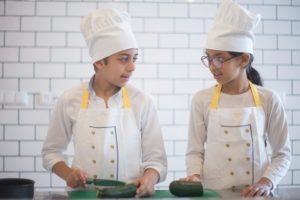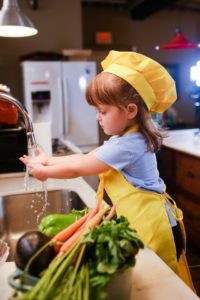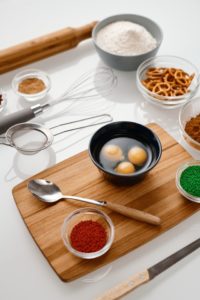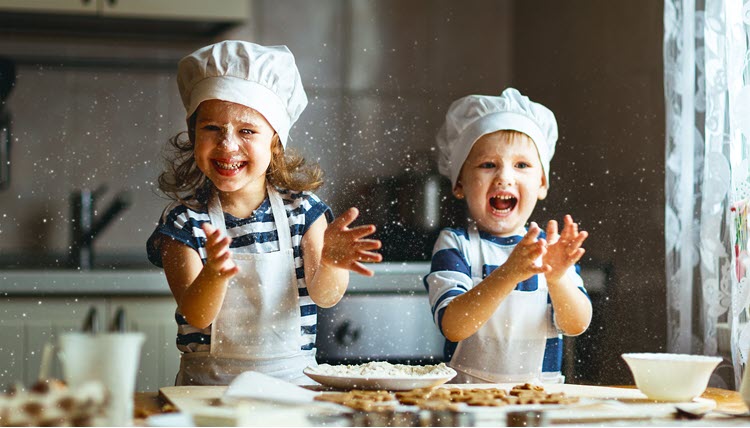Cooking with kids in the kitchen creates bonding moments for you and your child while teaching life skills. It’s also a really fun family activity. Though cooking is often enjoyable and rewarding, it’s also an educational opportunity.
Kids have a lot to learn when it comes to cooking and kitchen safety is important. Contact with a hot surface or flame accounts for the most burns in children, especially those 5 years of age and older, according to Safe Kids Colorado. Children 4 years of age and under suffer from scalds or burns from hot liquids.1
Follow our top 7 kitchen safety tips when cooking with your kids to help guide you in the kitchen.
1. Dress like a chef

Dress the part of a chef and sous chef – hair contained, clean, well-fitted clothing, and durable shoes. Consider a kitchen apron for the occasion to protect your clothes from spills and splatters. Make sure the apron strings are tied securely and out of the way. Tie back loose hair or don a chef’s hat to keep hair out of your face and food. Wear fitted clothes so nothing dangles, falls, or drapes where it could get caught or snagged on something, or catch fire from the stove. Wear comfortable shoes that provide traction on your kitchen floor to protect your feet and give you a better grip when moving around.
2. Prep like a chef

Before you begin cooking with your kids, declutter and clean your food preparation and cooking area – be it countertops or tables. Depending on the age of your child, make sure your little one can’t reach anything dangerous and that all loose cords, pointy objects, and electrical appliances are secured or put away. If necessary, move knives and scissors, and lock any drawers that may contain items harmful to children. Adjust the lighting in your kitchen so it’s bright and cheery, and everyone can see what they’re doing. Wash your hands so you’re ready to dive into your recipe.
3. Read your recipe from start to finish before beginning
Go over your recipes thoroughly or talk through your cooking ideas before beginning. Reading through a recipe – ingredients, measurements, and instructions, helps prevent missing an ingredient or forgetting the right piece of equipment. Cooking with kids should have your full attention – you don’t want to be rummaging around your cabinets while there’s food bubbling on the stove and no eyes on your child.
4. Prepare the mise en place

Mise en place – French for ‘putting in place’. Gather all of your ingredients once you’ve read through your recipe. Place the ingredients where they’re easy to get to. Assemble the kitchen gadgets or countertop appliances you’ll be using, such as bowls, mixers, utensils, measuring cups, and any other necessary items your recipe calls for. Keep your mise en place within an arm’s length so that all of your kitchen and cooking items are easy to access.
5. Review basic kitchen safety tips
Whether you have your own set of house rules for the kitchen or not, review basic kitchen safety tips with your kids before you get started. Lay the groundwork for what your child will be helping with so they’re aware of what is and isn’t off limits. Go over the dangers of the stove, risk of injury, how to use the fire extinguisher, and the location of the first-aid kit.
Quick tips:
- Pay close attention to every task.
- Take your time and be cautious.
- Use potholders or oven mitts.
- Clean up spills right away.
- Never leave cooking food unattended.
6. Discuss food safety handling and storag
Keep you and yours healthy following food safety handling and storage guidelines set by the Food Safety and Inspection Service of the U.S. Department of Agriculture, or USDA. This kitchen safety tip when cooking with kids can help prevent foodborne illness through proper washing, preparation, cooking, and storing of your food.2
7. Determine your child’s personal kitchen skill level for appropriate tasks

When determining what kitchen tasks to give your child, consider their maturity and dexterity skill level. A general age guideline is as follows:3
- Ages 2 to 3 years old – Needs close supervision, a lot of space, able to use large bowls and big spoons.
- Ages 3 to 5 years old – Get ingredients, stir, pour, rinse, and use non-metal cookie cutters.
- Ages 6 to 8 years old – Use a butter knife, peel vegetables, grate, measure, and set the table.
- Ages 9 to 12 years old – Follow recipes, use kitchen gadgets, plan meals, and use the stove.
- Ages 13 years old and above – Use the stove unsupervised.
Cooking with your kids can be a rewarding experience. Teach kids early how to respect the kitchen space to help prevent or avoid dangerous problems in the future. According to Nationwide Children’s, most home cooking fires started from an unattended stove.4 Follow our kitchen safety tips when cooking with kids and help keep your family safe.
Article Sources
Safe Smart Family uses only high-quality sources, including peer-reviewed studies, to support the facts within our articles. Read our editorial process to learn more about how we fact-check and keep our content accurate, reliable, and trustworthy.
- Holiday Kitchen Safety Tips. Childrenscolorado.org. Accessed May 19, 2022
- Food Safety Basics. Fsis.usda.gov. Accessed May 20, 2022
- Holiday Kitchen Safety Tips. Childrenscolorado.org. Accessed May 19, 2022
- Cooking Safety. Nationwidechildrens.org. Accessed May 19, 2022


